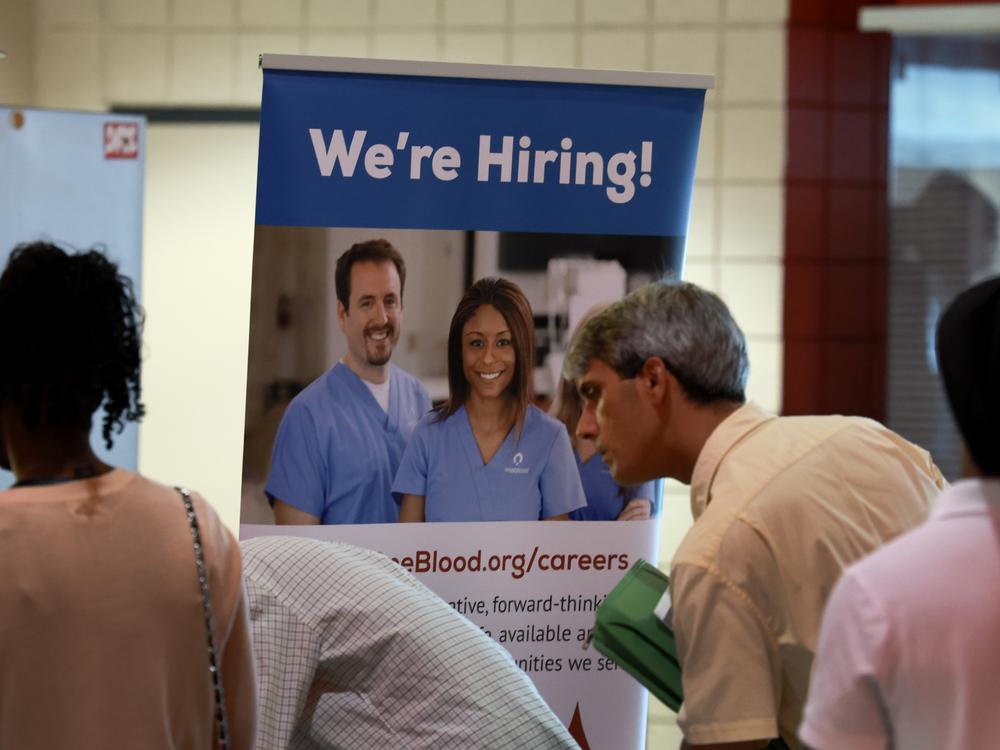Section Branding
Header Content
Why a weaker jobs market is sparking recession fears
Primary Content
The U.S. added far fewer jobs than expected last month, raising worries about a broader economic slowdown.
Employers added just 114,000 jobs in July, according to a report Friday from the Labor Department. That marked a sharp drop from the average monthly gain over the last year.
Loading...
Meanwhile, the unemployment rate rose to 4.3% in July, the highest level in nearly 3 years.
Here are three things to know about what the jobs report may be showing about the state of the economy.
Why the data is raising recession fears
The U.S. economy has been remarkably resilient over the last year despite the highest interest rates in more than two decades. But the sharp downshift in hiring last month is sparking fears that's about to change.
Employers added just over half as many jobs last month as they had, on average, in the twelve previous months. Job gains for May and June were also revised downwards by a total of 29,000.
While the unemployment rate is still low by historical standards, the three-month average has now risen more than half a percentage point from its 12-month low — a warning sign of a possible recession.
Loading...
Wage gains also cooled last month. Average wages in July were up 3.6% from a year ago, compared to an increase of 3.9% for the twelve months ending in June. Wages have been growing faster than prices for more than a year, increasing the average worker's real buying power.
Consumer spending is the biggest driver of the overall economy, so any significant drop in buying power could lead to a more widespread economic slowdown.
The jobs report follows an equally gloomy survey of manufacturing managers, which showed new orders and factory output shrinking in July. That triggered a stock market selloff on Thursday, which continued on Friday.
The Dow Jones Industrial Average tumbled more than 900 points in early afternoon trading, while the S&P 500 and the Nasdaq also slumped.
Some parts of the economy are clearly limping. Factories added just 1,000 jobs in July. The information sector, which includes publishing, broadcasting and web hosting, was the biggest loser last month, shedding 20,000 jobs.
But construction companies — which are typically sensitive to high borrowing costs — continued to hire at a rapid clip, adding 25,000 jobs in July.
The data is raising concerns about the Fed's approach
The weaker-than-expected jobs report sparked fresh worries that the Federal Reserve has kept interest rates too high for too long in its effort to curb inflation.
The central bank held its benchmark interest rate steady on Wednesday — at the highest level in more than two decades — but signaled that it could begin cutting interest rates at its next meeting in September.
Investors had been expecting a quarter-point rate cut at next month's meeting, but after Friday's jobs report, many are betting on a more aggressive, half-point reduction.
Critics worry that after being slow to raise interest rates three years ago, when prices started climbing rapidly, the Fed has once again failed to pivot in time to avoid a sharper slowdown.
Fed policymakers did say this week that they're keeping a close eye on the job market after a long period in which they were primarily concerned with battling inflation.
But there are some big caveats in the report
While the Labor Department says bad weather did not significantly affect the employment picture, Hurricane Beryl made landfall during the week the jobs numbers were gathered, so some of the job losses may be temporary.
Additionally, the rise in the unemployment rate was primarily driven by a surge of new workers: 420,000 people joined or rejoined the workforce in July, and not all of them found jobs right away. And the share of working-age people who are either working or looking for work rose to 84% — the highest level since 2001.
The Fed's next meeting is in mid-September, and policy makers will get another employment report and two additional inflation reports before that, which would provide a fuller picture.

